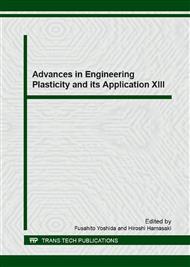p.238
p.243
p.249
p.255
p.261
p.267
p.275
p.281
p.287
Development of Simulation Technology for Production of Porous Polymeric Membranes
Abstract:
Porous polymeric membranes are used for ion exchange membranes, membrane filter and separators of batteries owing to its micro-porous structure. Extension method is one of the inexpensive processes of such membrane. However, any suitable stability condition of the process has not yet been clarified. In this study, SEM (Scanning Electron Microscope) observations in production process are carried out and the simulation technology for production is developed for improvement in productivity. In this simulation model, the evolution equation of microscopic damage, constitutive equation depending on microscopic damage and the homogenization method are used for representation of evolution of micro-porous structure of crystalline polymer. It is indicated that numerical results obtained here are in good agreement with the SEM observations.
Info:
Periodical:
Pages:
261-266
Citation:
Online since:
December 2016
Price:
Сopyright:
© 2017 Trans Tech Publications Ltd. All Rights Reserved
Share:
Citation:


